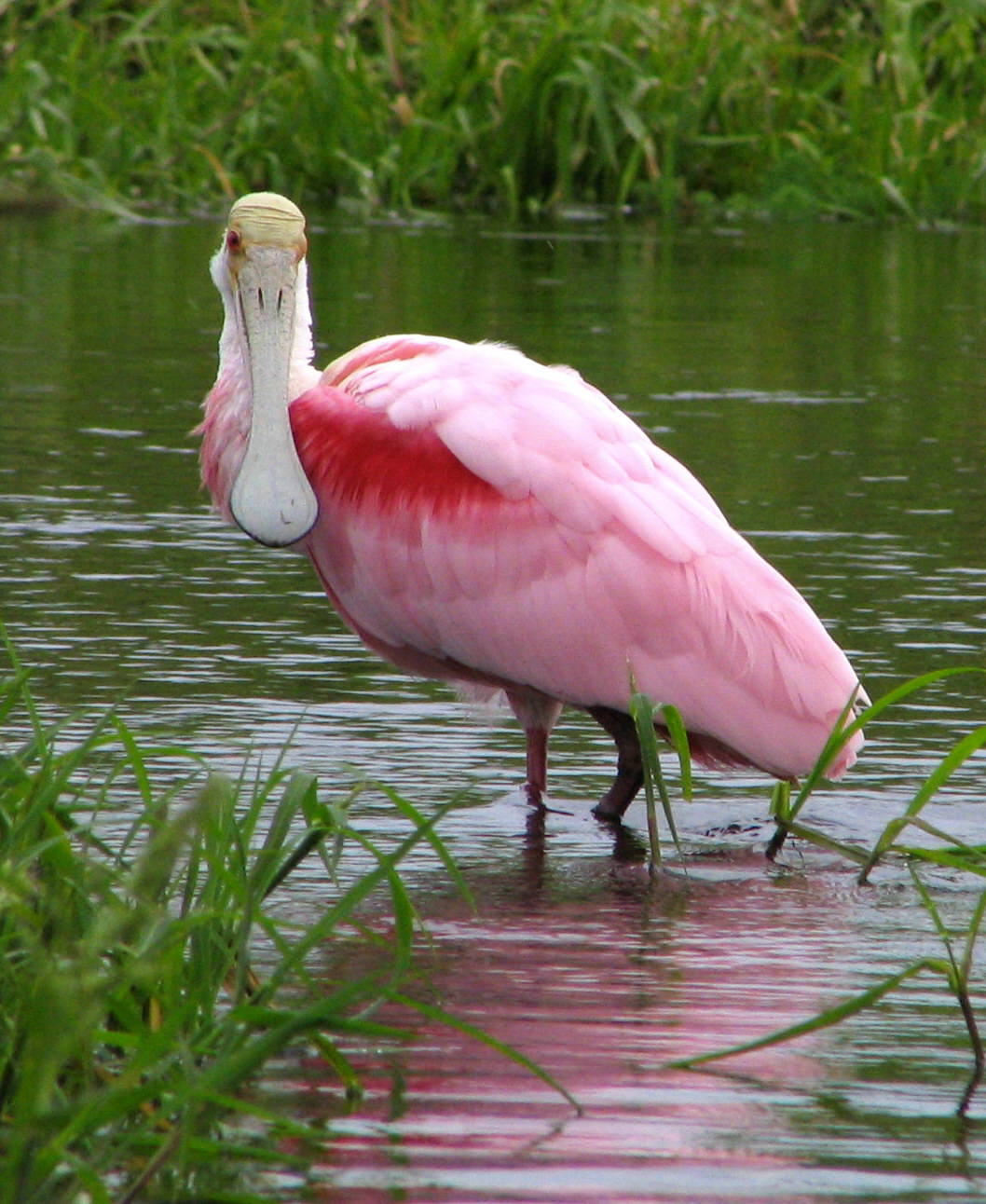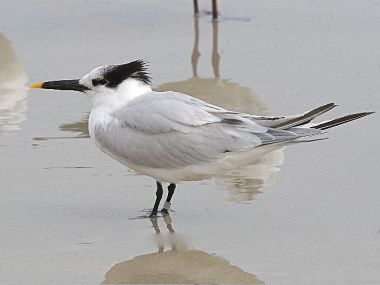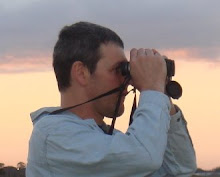
Wilson’s Plover
Image Credit: tringa.org
Keeping with tradition, I spend another Xmas holiday in the Sunshine State. I was happy to leave the cold and snow shoveling back in Pennsylvania where they belong. As always, I spent a fair amount of time taking in the birds. Info on field guides and bird finding guides can be found in the report for my previous Florida birding trip.
For this trip, I visited a few of the sites from previous trips, and I also added a few new locations. As on previous trips, I did a fair amount of birding within 30 minutes of Kissimmee, the home of the immortal Vassar Clements.
Central Florida
The first two places I visited were in Central Florida, about an hour north of Kissimmee. The primary goal for our first destination, De Leon Springs State Park, was not avian. And unlike last year, it was not the manatees we sought. This year, it was pancakes at the Sugar Mill Inn. After checking in with the hostess, we had to wait about an hour to be seated. I used this hour to search the nearby shrubbery and waterside for birds. As expected, Palm Warblers were abundant. Although it was exciting to see such a concentration of warblers, the highlight by far was a lone male Painted Bunting. He was undoubtedly the handsomest fella I encountered during the entire Florida trip.

Painted Bunting
Image Credit: Collin County YMCA
After my gluttonous encounter at the pancake house, we made our way over the Blue Springs State Park to take in the manatees. We also took a short “cruise” up the St. John’s River to look for birds. Waders were abundant, as were Vultures and Bald Eagles. The vultures were particularly interesting. Turkey Vultures, which I have encountered many times in Pennsylvania, are quite skittish. They don’t seem to like being around people – at least not live ones. Black Vultures, on the other hand, are down right creepy. They seem to be attracted to people and will take up a perch just above where you happen to be –as if they are patiently waiting around for you to kick the bucket. It makes one think twice before snoozing off in a hammock. Vultures aside, the highlight of the St. John’s trip was a Yellow-crowned Night Heron perched in a tree along the banks of the river.

Yellow-crowned Night Heron
Image Credit: Tom Dempsey
Two other prime spots for birding in the Kissimmee area are the Joe Overstreet Road and the Disney Wilderness Preserve. The Joe Overstreet Road is an unpaved road leading past cattle pastures and sod farms on the way to the east side of Lake Kissimmee. The Disney Wilderness Preserve is a mix of pine flatlands, oak scrub and wetlands adjacent to Lake Hatchinea.
The targets along the Joe Overstreet Road were Loggerhead Shrike and Sandhill Cranes, both of which were seen in abundance. There were also a fair number of Bald Eagles observed as we approached the lake. However, the highlight was a pair of Whooping Cranes that have been frequenting the area for several years. The Whooping Cranes are part of a program to re-introduce the birds to Florida.

Whooping Crane
Image Credit: Birdfinders
At the Disney Preserve, which is managed by the Nature Conservancy, the level of activity was somewhat subdued. It was quite chilly and overcast the day I went there – about 40°F. There were a few Eastern Meadowlark and Loggerhead Shrike observed along the entrance road, and a few Sandhill Crane could be heard bugling in the distance. Other than a few Palm Warblers, not much else was observed along the road or around the visitors center. I decided to hike the scrub trail adjacent to the lake. My targets were Bachman’s Sparrow and Brown-headed Nuthatch. For most of the trail, the birding was not so good, probably due to the weather. However, I did encounter a wave of birds moving through the scrub. They were primarily a mix of Palm, Yellow-rumped, and Pine Warblers. Traveling along with the warblers were a small handful of Brown-headed Nuthatch. Bachman’s Sparrow proved to be elusive. I did see several sparrow-like birds along the trail, but they dropped down into the heavy underbrush and I failed to draw them out. As such, I was unable to verify their ID. Guess I’ll have to go back again next year…

Brown-headed Nuthatch
Image Credit: Birds & Buildings
Gulf Coast – Sanibel Island
In addition to local birding, I also made a field trip to Sanibel Island on the Gulf Coast. On Sanibel, I had two locations on my list of places to go, Ding Darling National Wildlife Refuge, and the beach adjacent to the Island Inn where we were staying. To my surprise and delight, the birding actually began on the causeway from the mainland to the island. Just before reaching the toll plaza, I spotted a Swallow-tail Kite on the sign support arching over McGregor Blvd. I also spotted several other birds near the causeway islands, such as Osprey, Brown Pelicans and Laughing Gulls. Overall, birding was limited on the causeway because the tide was up.

Roseate Spoonbill
Image Credit: Academic Dictionary
Upon reaching the island, we headed straight for Ding Darling NWR. The birding was fantastic. At our first stop, we observed large flocks of White Pelicans and Roseate Spoonbills, and a sizeable mixed flock of shorebirds, which included Willets, Wilson’s Plovers, Least Sandpipers and both Long-billed & Short-billed Dowitchers. As we continued along the road, we observed a variety of herons and egrets, as well as several Common Ground Doves.

Sandwich Tern
Image Credit: Kate St. John
The following morning, I got the kids up before sunrise to get out to the beach at low tide, with flashlights in hand, to collect shells. Surprisingly, we were not alone. In fact, we were late comers, as the beach was already bustling with a dozen or so other shell collectors. Rather than collect shells, I set up my tripod and spotting scope and scanned the beach and gulf for shorebirds, gulls and terns. Once the sun came up, there was quite a bit to see. The highlights for me were the Sanderlings running along the surf line and the various terns (Sandwich, Forster’s & Royal) diving for fish.
Other Sightings
I also made a few limited outings while doing other things, like shopping, visiting friends or touring the Venus Project with Jacques Fresco and Roxanne Meadows. On the grounds of the Venus Project, I observed several warblers, including a male Yellow-throated Warbler. I also found several owl pellets from an unID’d owl.
Overall, the trip was quite productive. In total, I observed 94 species, five of which (Painted Bunting, Wilson's Plover, Sandwich Tern, Common Ground Dove, Brown-headed Nuthatch)were lifers for me. As with any birding trip, there were a few disappointments, the most notable of which occurred during an attempted outing to the Muck Farms between Zellwood and the north reclamation area of Lake Apopka. To my great disappointment, these areas were fenced off and apparently off-limits to the general public. I had hoped to get back on the Hopper Farm Road to look for roosting tyrannids, which reportedly include Western & Cassin’s Kingbirds, as well as the occasional Scissor-tailed Flycatcher. Hopefully these areas will be accessible in the future. Disappointed, but not completely deflated, I made my way over to Trimble Park in search of the elusive Limpkin. Unfortunately, I was unable to find it.
Maybe next year….
Below is a summary of my observations. If anyone has questions as to where a particular bird was spotted, please feel free to post a question here.
American Black Duck 2
American Coot 20
American Crow 1
American Goldfinch
American Kestrel 8
American Robin 60
American White Pelican 80
Anhinga 1
Bald Eagle 2
Belted Kingfisher 1
Black Vulture 10
Black-bellied Plover 1
Blue Jay 2
Blue-gray Gnatcatcher 2
Blue-headed Vireo 2
Blue-winged Teal 4
Boat-tailed Grackle 10
Brown Pelican 6
Brown-headed Nuthatch 3
Carolina Wren 2
Cattle Egret 15
Cedar Waxwing 20
Common Ground-Dove 1
Common Moorhen 20
Double-crested Cormorant 1
Downy Woodpecker 1
Dunlin 20
Eastern Meadowlark 1
Eastern Phoebe 2
Eastern Towhee 2
Eurasian Collared Dove
Fish Crow
Forster's Tern 10
Glossy Ibis 28
Gray Catbird 1
Great Blue Heron 1
Great Egret 3
Green Heron 1
Herring Gull 5
Hooded Merganser 18
Killdeer 2
Laughing Gull 8
Least Flycatcher 1
Least Sandpiper 20
Lesser Scaup 21
Little Blue Heron 1
Loggerhead Shrike 4
Long-billed Dowitcher 20
Mallard 16
Mourning Dove 2
Muscovy Duck (Domestic type) 4
Northern Cardinal 1
Northern Harrier 1
Northern Mockingbird 1
Osprey 5
Painted Bunting 1
Palm Warbler 5
Pied-billed Grebe 1
Pileated Woodpecker 2
Pine Warbler 26
Red Knot 8
Red-bellied Woodpecker 3
Red-breasted Merganser 1
Red-shouldered Hawk 5
Red-tailed Hawk 1
Red-winged Blackbird 20
Ring-billed Gull 4
Rock Pigeon 12
Roseate Spoonbill 200
Royal Tern 2
Ruby-crowned Kinglet 1
Ruddy Turnstone 1
Sanderling 6
Sandhill Crane 100
Sandwich Tern 6
Savannah Sparrow 25
Semipalmated Plover 20
Short-billed Dowitcher 10
Snowy Egret 3
Sora 1
Swallow-tailed Kite 1
Tree Swallow 200
Tricolored Heron 1
Tufted Titmouse 2
Turkey Vulture 1
White Ibis 6
Whooping Crane 2
Wild Turkey 14
Willet 50
Wilson's Plover 15
Wood Stork 2
Yellow-crowned Night-Heron 1
Yellow-rumped Warbler 1
Yellow-throated Warbler 1



2 comments:
A very impressive bird list! For Limpkins you should come on over to Lakeland in more Western Polk County. You were very close while near Kissimmee. We have them everywhere in the lakes around town. And a wonderful assortment of wading birds, hawks, eagles, wood storks and white pelicans at a place called Circle B Bar Preserve and elsewhere throughout the county. It is very early for a Snail Kite to be in Florida! I don't usually see them until late Feb, early March! Enjoyed reading your blog. Thanks for enjoying the birds in Florida.
Okay I meant to say "very early to see Swallow tail kite in Florida." The Snail Kites are here year round but I thought the Swallow tails only come up from S.A. to nest here. (?) Isn't this right?
Post a Comment